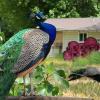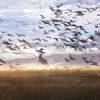- Formiculture.com
- Forums
- Gallery
- Members
- Member Map
- Chat

Sacramento CA, April 17th, 2019
Started By
Jefw1f
, Apr 17 2019 9:50 PM
3 replies to this topic
#1
 Offline
-
Posted April 17 2019 - 9:50 PM
Offline
-
Posted April 17 2019 - 9:50 PM
1. Location (on a map) of collection: 1501 Northgate Blvd, Sacramento, CA 95815
2. Date of collection: April 13th 2019
3. Habitat of collection: on hard packed dirt. In a seating area. Nesr an open field, woods, river, and flower garden.
4. Length (from head to gaster):
5. Color, hue, pattern and texture: Black, deep red legs. Gold reflections on gaster.
6. Distinguishing characteristics:
7. Distinguishing behavior:
8. Nest description:
9. Nuptial flight time and date:
I saw 3 ant species all in the area so I have no clue what they may be. I caught 3 in total. One only has one wing, the other 2 do not have wings. They are all acting different. The winged queen seems distressed and wanting to get rid of her wing and keeps paying attention to he gaster.
Another is sitting on the water cotton ball barely moving. The third moves around near the cotton.
https://drive.google...ew?usp=drivesdk
https://drive.google...ew?usp=drivesdk
https://drive.google...ew?usp=drivesdk
#2
 Offline
-
Posted April 18 2019 - 8:57 AM
Offline
-
Posted April 18 2019 - 8:57 AM
The one in the 2nd picture is probably Dorymyrmex insanus. They fly early in the year and have red mandibles. Give me the size of the queens in milimeters so I can confirm the species. I don't know if the other 2 pictures are different species.
Edit: I think they're all D. insanus
Edit 2: Queens that keep cleaning their gaster are typically mated.
Edited by Somethinghmm, April 18 2019 - 9:05 AM.
- Jefw1f likes this
#3
 Offline
-
Posted April 18 2019 - 9:27 AM
Offline
-
Posted April 18 2019 - 9:27 AM
The 2nd and 3rd pictures are of the same queen.
The first queen is the one that I am concerned about surviving. I keep checking on her and she looks shriveled and is laying on her side as if she has died, but when I open the tube she moves again. Hopefully the other two queens survive and are mated also.
Thanks for the initial ID I will try and measure one of them soon. I don't want to keep disturbing them.
The first queen is the one that I am concerned about surviving. I keep checking on her and she looks shriveled and is laying on her side as if she has died, but when I open the tube she moves again. Hopefully the other two queens survive and are mated also.
Thanks for the initial ID I will try and measure one of them soon. I don't want to keep disturbing them.
#4
 Offline
-
Posted April 19 2019 - 5:21 PM
Offline
-
Posted April 19 2019 - 5:21 PM
The one in the 2nd picture is probably Dorymyrmex insanus. They fly early in the year and have red mandibles. Give me the size of the queens in milimeters so I can confirm the species. I don't know if the other 2 pictures are different species.
Edit: I think they're all D. insanus
Edit 2: Queens that keep cleaning their gaster are typically mated.
One Queen Died so I was able to get a good measurement. Please see the link!
https://drive.google...ew?usp=drivesdk
She appears to be 6-7 mm in length.
All three are about the same size.
https://drive.google...ew?usp=drivesdk
Also I was able to get a pretty good photo of her face.
0 user(s) are reading this topic
0 members, 0 guests, 0 anonymous users













